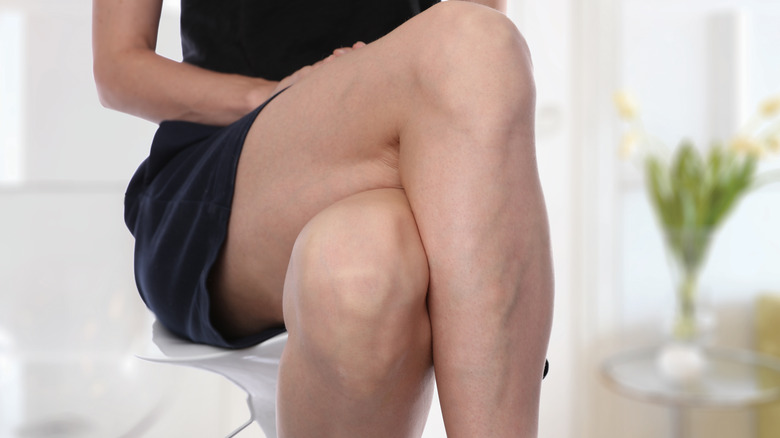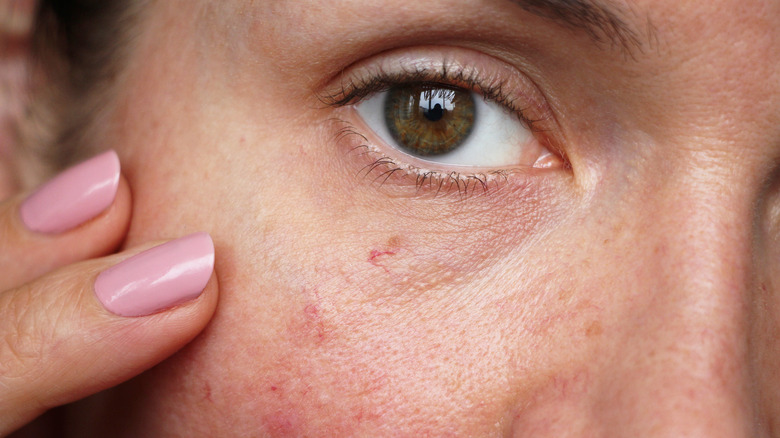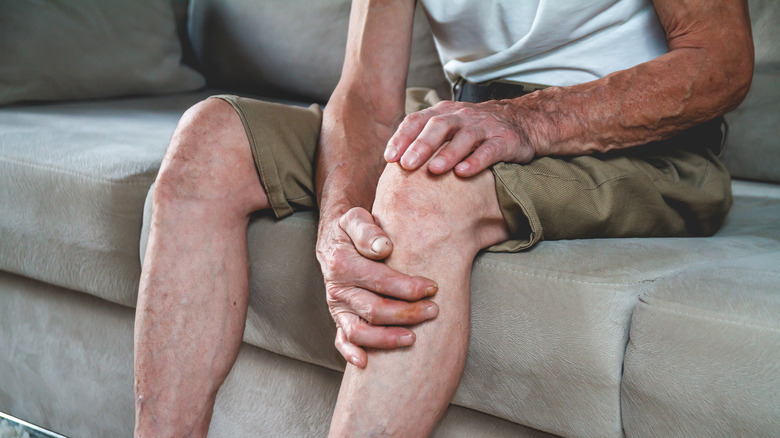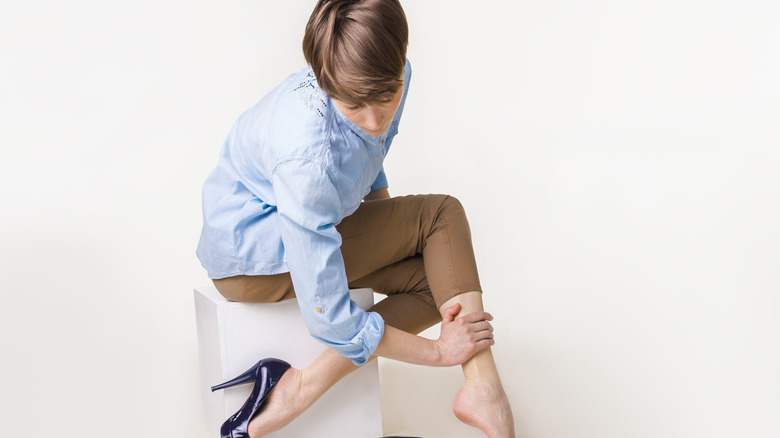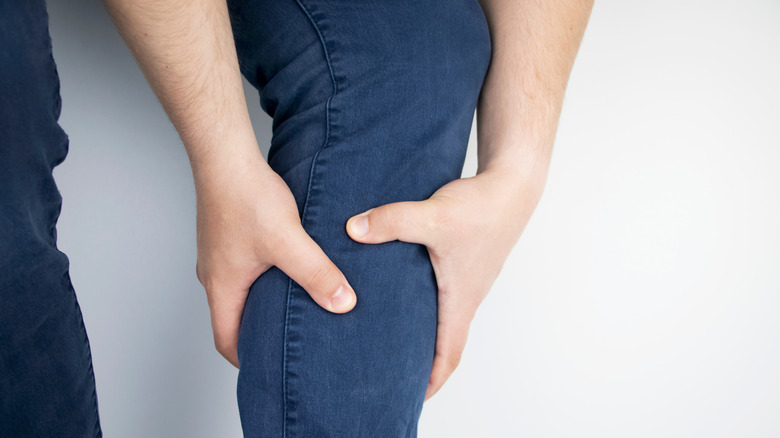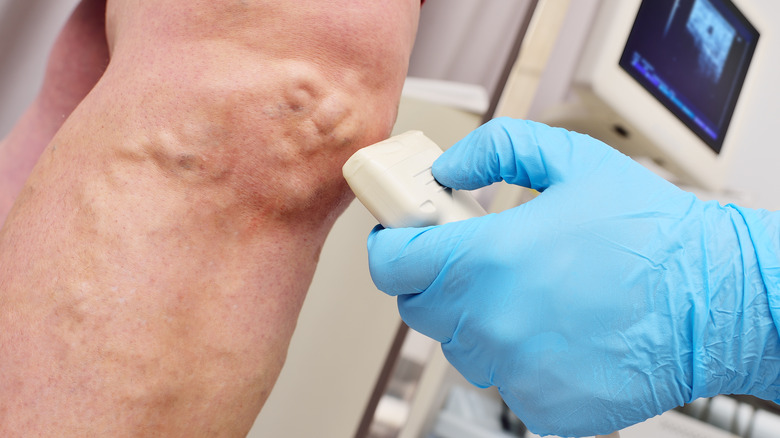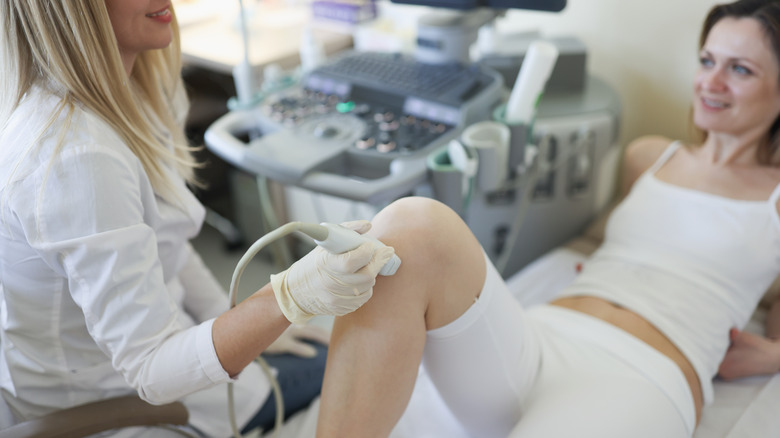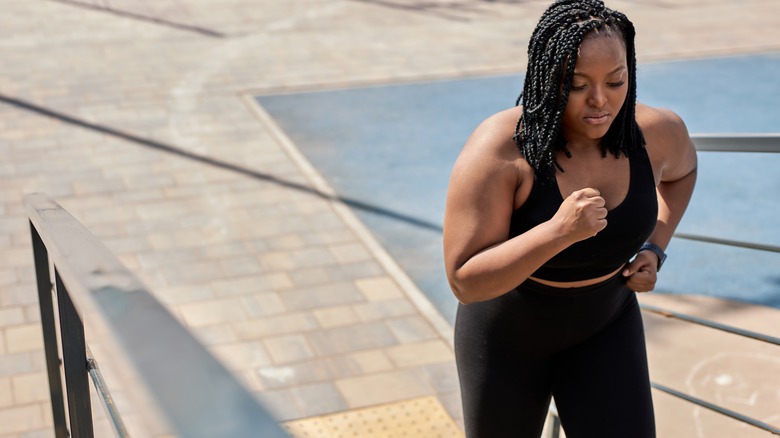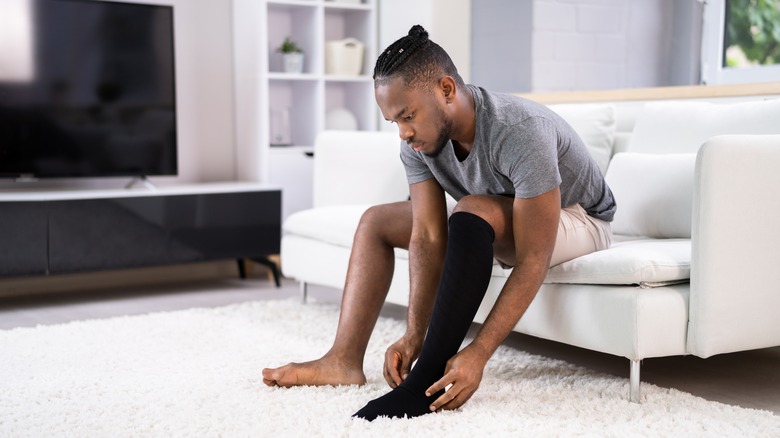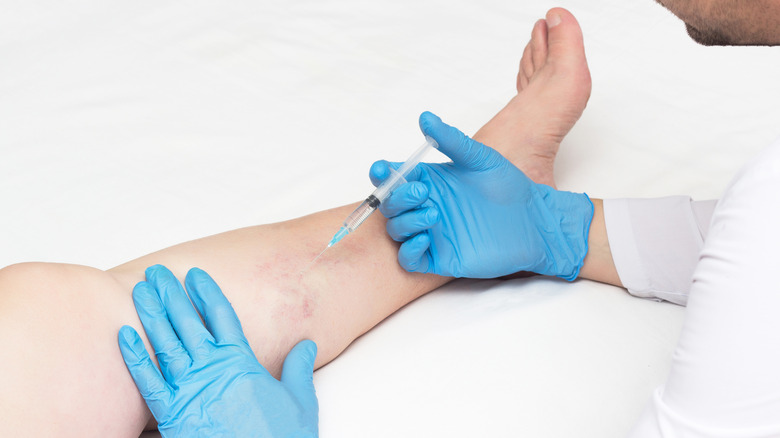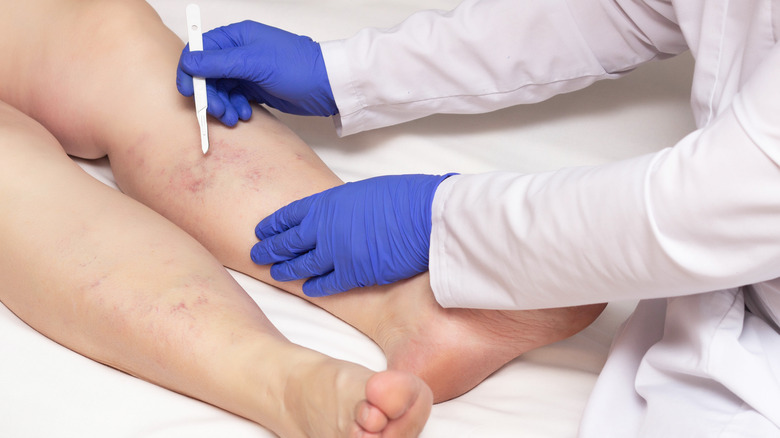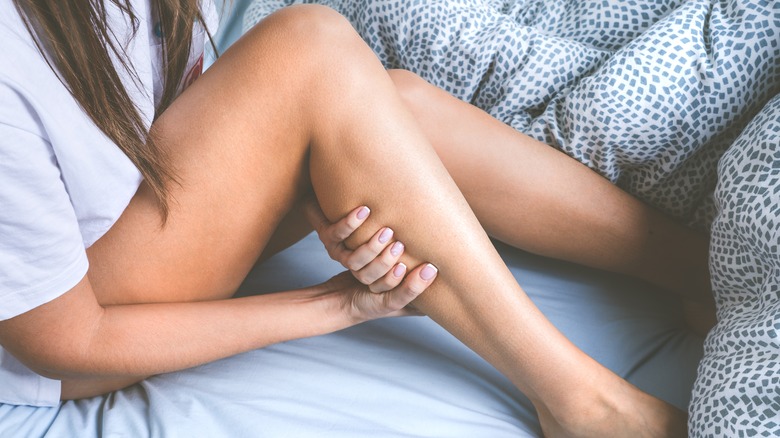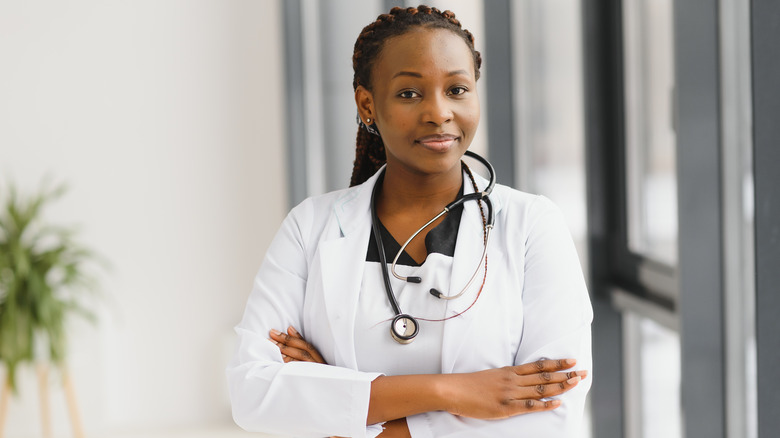Varicose Veins: Causes, Symptoms, And Treatments
If we asked you to think of two words that make you squirm, varicose veins are probably not too far down the list. Most of us, unfortunately, are all too familiar with this pesky condition. In fact, more than 40 million people in the U.S. deal with varicose veins, and half of that number is made up of people who are 50 and older, according to Prevention.
Board-certified dermatologist Tsippora Shainhouse told Prevention that varicose veins form when the one-way valves in veins malfunction. When a vein's valve fails to close properly, blood starts to accumulate. This causes the vein to stretch, and the result is visible blue veins that sometimes appear twisted. Weak vein walls can also cause varicose veins, according to the Cleveland Clinic. These veins usually appear on the legs, feet, or ankles, so when summertime hits, it's hard to hide them.
Many people may use the terms varicose veins and spider veins interchangeably, but they don't mean exactly the same thing. Spider veins are a type of varicose vein that is thinner and smaller than other kinds (per Johns Hopkins Medicine). As the name suggests, this condition resembles blue or red spider webs just beneath the skin, and unlike most varicose veins, they can show up anywhere on your body. People often get them on their faces, behind their knees, or on their feet.
Dealing with varicose veins can be daunting, so read on for everything you need to know about this condition, how it's diagnosed, and the best ways to treat it.
There are different types of varicose veins
All varicose veins are not created equal, and there are actually various types of varicose veins that can develop, according to the National Health Service (NHS). You might be most familiar with trunk varicose veins. These are the type of varicose veins that are most visible because they develop close to the skin's surface. They are usually thick in appearance and tend to bulge. It's common for these types of veins to be pretty long. Reticular varicose veins, instead of presenting as one big bulging vein, usually appear in groups. They are typically red in color. Then there are telangiectasia varicose veins, which is the medical term for spider veins, also referred to as thread veins. As previously mentioned, these veins can be less noticeable because they don't bulge like other types of varicose veins. They're also completely harmless and tend to appear in other places on the body aside from the legs. They are usually blue or red in color and have a similar shape to a spider web.
Causes of varicose veins
While varicose veins can be caused by a myriad of things, weak valves in the veins are usually the main culprits (via Women's Health). The reason varicose veins are more common in the legs is that the veins in this area have a tough job to do — they literally have to operate against gravity to bring blood to the heart.
In order for our bodies to function normally, capillaries and arteries work hard to distribute blood to the entire body from the heart. Your veins, on the other hand, work to return the blood to the heart to complete the circle. The valves in these veins have one job: to prevent blood from flowing backward. Sometimes, these valves become weak or damaged to the point where they can no longer function at all. This is when blood starts to flow back into the vein instead of upward, and it slowly starts to accumulate. The vein expands to accommodate the pooled blood and eventually becomes permanently enlarged, according to the NHS. Accumulated blood can also cause the veins to become twisted, which leads to an even bulgier look on the surface (via Mayo Clinic).
Some are more prone to varicose veins than others
While the cause of varicose veins is pretty simple to understand, you're probably curious about what can trigger the demise of the valves in your veins. Unsurprisingly, your genetics can play a significant role. According to a 2019 study published in PLOS Genetics, varicose veins are hereditary, which means that if some of your family members deal with this condition, you're more likely to develop it during the course of your life as well. Gender is another factor. Women are more prone to developing varicose veins than men. According to the Mayo Clinic, changes in female hormones during the menstrual cycle, pregnancy, or menopause can encourage the vein walls to relax, which is one of the causes of varicose veins. Some chronic medications, like oral contraceptives, can also increase your risk of developing this condition.
Pregnancy is another risk factor. In order to accommodate the baby, the body increases its blood supply. Naturally, this causes veins to stretch, especially in the leg area. Other everyday activities can also lead to varicose veins. If you stand or sit for long periods of time during the day without moving around much, blood flow isn't as sufficient, creating the perfect environment for varicose veins to develop. Existing conditions like obesity can also play a role. When the body is overweight, extra pressure is put on the veins. Age is also a factor: As we get older, the valves in our veins start to become worn out, allowing blood to flow backward.
Symptoms of varicose veins
Noticing dark purple or blue, bulging veins popping up on your legs is usually a surefire sign that you're dealing with varicose veins, but you might notice additional, less obvious symptoms as well (per the NHS).
While varicose veins are typically painless, you might experience some discomfort. This can include skin that is dry and itches in the area of the varicose vein, as well as a throbbing or burning sensation in the legs. Other symptoms can include swelling of the feet and ankles, muscle cramps that tend to show up at nighttime, and a heavy, aching sensation in the legs. In some cases, varicose veins can also cause the skin around them to become discolored, and in severe cases, it can lead to the development of venous ulcers on the surrounding skin, according to the Cleveland Clinic.
While these symptoms can pop up at any time, you might notice that they tend to make an appearance when you've been standing all day (via the NHS). You'll usually feel a little better if you move around for a bit, sit down, or raise your legs. Warmer weather can also trigger symptoms. If you're dealing with severe symptoms like venous ulcers, it's important that you contact your doctor to prescribe treatment.
Varicose veins could lead to some complications
While varicose veins are typically harmless, it's usually a good idea to get them checked out by a doctor. In some cases, varicose veins can lead to additional health complications, but this can be avoided if proper treatment is administered in time.
Speaking to Women's Health, the medical health director of the Vein Center of East Texas, Jeffrey G. Carr explained that it's imperative you make an appointment with your doctor if your varicose veins are presenting symptoms that are affecting your daily life. If they are swollen, painful to the touch, are causing sores to develop, or start bleeding, it's time to take action. "Left untreated and ignored over time, there can be marked skin changes in the legs and poor vascular health that can lead to non-healing ulcers or wounds and even blood clots," Carr warns.
Other complications include poor circulation as well as blood clots that cause inflammation in the affected vein, a condition referred to as thrombophlebitis (per Medical News Today). Varicose Veins can also lead to deep vein thrombosis, or the formation of a clot in the vein. Another complication that may arise is inflammation in the fat found under the surface of the skin. This leads to a condition called lipodermatosclerosis, which usually affects the lower part of the legs and manifests as changes in skin color and skin hardening, according to the Genetic and Rare Diseases Information Center. Varicose eczema, a condition that causes scaly, dry, itchy, and swollen skin is another known complication (via the NHS).
How varicose veins are diagnosed
Diagnosing varicose veins usually isn't a complex process. Doctors will typically start off by performing a visual examination. They'll ask you to stand so they can examine your legs and check if there are any swelling or visible bulging veins, according to Medical News Today. Your doctor might also ask you about your medical history and whether you're experiencing any other symptoms that are painful or concerning. In some cases, they might refer you to a vascular specialist for treatment.
Aside from a visual examination, your doctor might order additional medical tests, like a doppler test (a.k.a. a duplex ultrasound). This test helps doctors to assess the structure of the veins in your legs as well as the blood flow, according to Johns Hopkins Medicine. This test consists of two ultrasounds, and the technician will perform one or both depending on the doctor's specifications. One is a Gray scale B-mode ultrasound. This one helps doctors to study the structure of your veins. The color-flow doppler ultrasound is what will give doctors an idea of how well blood flows through your veins.
Your doctor might also order a venogram. This consist of injecting a dye into your veins and then taking an X-ray. The dye shows up on the x-rays and gives the doctor a clear picture of the blood flow through your veins, according to Healthline. All these tests help your doctor to rule out other issues like blockages and blood clots.
There are things you can do to prevent varicose veins
Yes, varicose veins suck, but luckily there are steps you can take to prevent them from making an appearance. "The best way to prevent the veins from forming is leading an active lifestyle," board-certified plastic surgeon Benjamin Cousins told Prevention. "Leg exercises such as jogging and walking will help [stimulate] blood circulation," he added. For those of us who love our high heels, Cousins says to be cautious of how much you wear them. "Flats actually help tone the calf muscle more, which can help prevent varicose veins from forming," he explains. If you've been looking for a reason to ditch heels for good, this is it.
The Cleveland Clinic also recommends you avoid sitting or standing for prolonged periods of time. Moving around every now and then or doing some stretches in between sets of work can help keep up good blood circulation. Staying at a healthy weight for your body can also help you prevent varicose veins, since ridding the body of excess weight can actually help relieve the pressure your veins experience. Wearing loose-fitting clothes can also help. Opt for clothes that don't sit too tight around the waistline. Last, but not least, keep in mind that smoking can also cause varicose veins to develop. Blood vessels are damaged by tobacco use, not to mention that it also diminishes proper blood flow.
There are some home remedies you can try for varicose veins
When it comes to at-home remedies for treating the discomfort caused by varicose veins, moving around as much as possible — and particularly making sure to exercise your legs — is definitely a great place to start, according to the Office on Women's Health (OASH). Board-certified plastic surgeon Benjamin Cousins told Prevention that refraining from sitting cross-legged can also help relieve pressure on the legs, so make sure you sit with your legs uncrossed whenever you're having some downtime at home. Cousins also suggests that you elevate your legs above hip level when you're in the comfort of your home, especially after a long day of standing or sitting at work.
Another home remedy that can be very helpful is compression stockings. This might seem a bit counterintuitive, but when it comes to treating varicose veins, the tightness of the stockings can actually relieve swelling and tightness while also improving blood circulation in the lower parts of your legs. While compression stockings usually work great, it's important to note that they won't do anything to make existing varicose veins disappear. They do, however, provide relief from uncomfortable symptoms associated with the condition.
There are some medical treatments available for varicose veins
The most common non-surgical treatment for varicose veins is sclerotherapy, which is usually recommended for those who want to get rid of spider veins or smaller varicose veins (via OASH). It consists of a chemical injection into the vein that causes it to seal completely, transform into scar tissue, and eventually fade. Multiple treatments might be required, and new varicose or spider veins might still form.
Endovenous thermal therapy is another option and is usually implemented to treat larger veins on the surface of the legs. It consists of heating the vein and then closing it permanently. This is done by placing a tube with a probe into the vein, and laser or radio waves are used to complete the sealing process. Skin surface laser treatments are another option for spider veins and very small varicose veins. Several treatments are usually needed, and over time, it causes the veins to fade completely.
VenaSeal, one of the latest varicose vein treatments, is another fuss-free treatment you can consider instead of surgery. It consists of using a medical-grade adhesive to seal problem veins, and it takes just one session to complete. "It has been shown to be equally effective in permanently closing the veins as the thermal techniques," medical director of the Vein Center of East Texas Jeffrey G. Carr told Prevention. What's even sweeter is that it doesn't pose the usual risks like nerve injury, and you don't have to follow a strict aftercare regimen. It's also FDA-approved.
You can opt for surgery to remove varicose veins completely
If other treatments are unsuccessful, your doctor might recommend you get surgery to get rid of unsightly or problematic varicose veins. The surgical procedures available to patients all focus on removing the affected veins entirely (per OASH).
One surgery you could consider is ambulatory phlebectomy. Your doctor will recommend this procedure if you have varicose veins that appear just beneath the surface of your skin. The procedure consists of making small incisions to extract the vein from the leg. The doctor then uses hooks to grab hold of the vein and pull it out. While this sounds pretty unpleasant, you can usually go about your daily life again the next day, and while the incisions might leave scars, they're usually very small.
Vein stripping is another option. "This procedure is best for very large, painful, bulging varicose veins," board-certified dermatologist Tsippora Shainhouse told Prevention, adding, "It's usually performed by a vascular surgeon, but some dermatologic surgeons will do it." This procedure also consists of making small incisions in the legs to remove the problematic veins. It's not as popular among patients as ambulatory phlebectomy because it's much more painful, and recovery can take up to a month (via OASH). Some patients also experience a tingling feeling in the lower parts of their legs after the procedure. This is usually due to an irritated nerve triggered by the surgery.
Varicose vein surgery and treatments do involve some risks
As with any surgical procedure out there, varicose vein surgery comes with some risks. Before you jump in head-first, it's important to keep in mind that even with surgery, your varicose veins might return. In fact, according to the Cleveland Clinic, half of the patients who get varicose vein surgery deal with the condition once again five years later.
There are also some risks to keep in mind. While it's natural to expect scarring and the possibility of infection, surgery also poses more serious risks like deep vein thrombosis and injury to the nerves surrounding the vein. In some cases, skin burns might also occur.
Other non-surgical treatments like sclerotherapy can also cause some unwanted side effects, but they are less serious than that of surgical treatments. Patients who undergo this treatment might experience hardness or lumps in their legs for a couple of months post-treatment. The injections might also cause the surrounding skin to turn brown for a few months, while bruising or redness at the injection site post-treatment is also very common. And, as with surgical procedures, varicose veins might recur even after you undergo sclerotherapy.
When to speak to your doctor
While it's true that varicose veins are common and usually don't cause any painful symptoms, it's important you make your doctor aware that you have the condition. According to Healthline, varicose veins won't go away on their own, and they also tend to get more severe as time passes, regardless of simple steps taken to help manage the condition. For some, varicose veins can worsen to the point where medical treatment becomes necessary. The Cleveland Clinic warns that any swelling, discoloration, bleeding, or veins that are red, painful, and warm to the touch are an indication that it's time to make an appointment with your doctor as soon as possible.
Experiencing sores or ulcers on the legs is also an indication that you need urgent medical treatment. If you experience blood clots or a ruptured vein, it's time for a trip to the doctor — stat (per Healthline). It's best to make an appointment with your doctor early on so they can assess the severity of your varicose veins and treat them accordingly. This way, you'll prevent the condition from escalating beyond control.

